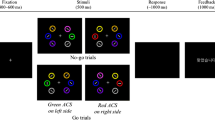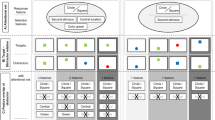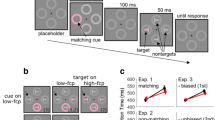Abstract
Different contexts with high versus low conflict frequencies require a specific attentional control involvement, i.e., strong attentional control for high conflict contexts and less attentional control for low conflict contexts. While it is assumed that the corresponding control set can be activated upon stimulus presentation at the respective context (e.g., upper versus lower location), the actual features that trigger control set activation are to date not described. Here, we ask whether the perceptual priming of the location context by an abrupt onset of irrelevant stimuli is sufficient in activating the context-specific attentional control set. For example, the mere onset of a stimulus might disambiguate the relevant location context and thus, serve as a low-level perceptual trigger mechanism that activates the context-specific attentional control set. In Experiment 1 and 2, the onsets of task-relevant and task-irrelevant (distracter) stimuli were manipulated at each context location to compete for triggering the activation of the appropriate control set. In Experiment 3, a prior training session enabled distracter stimuli to establish contextual control associations of their own before entering the test session. Results consistently showed that the mere onset of a task-irrelevant stimulus (with or without a context-control association) is not sufficient to activate the context-associated attentional control set by disambiguating the relevant context location. Instead, we argue that the identification of the relevant stimulus at the respective context is a precondition to trigger the activation of the context-associated attentional control set.


Similar content being viewed by others
Notes
Note, that for the study of RC compatibility effects the performance of Task 1 is the primary dependent measure. Performance in Task 2 is theoretically less important but is typically reported to control for trade-offs between tasks.
In a pilot study with equal font size, participants spontaneously reported that letters appeared larger in size than digits. This might be due to a wider horizontal extension of letters compared to digits. Therefore, we adjusted the size of letters to obtain a visually comparable impression.
It is conceivable, for example, that the requirement of re-orientation leads to a particular strong activation of the correct attentional control set, which might explain an increased CSPC effect in error rates of Block 2 in Experiment 3 when task-irrelevant stimuli appear first. We thank an anonymous reviewer for mentioning this possibility.
For the first block of Experiment 2, the CSPC effect (40 ms) was not significant, F(1, 19) = 1.68, p = .211 η 2p = .08, which might be due to a power problem.
References
Blais, C., Harris, M. B., Guerrero, J. V., & Bunge, S. A. (2012). Rethinking the role of automaticity in cognitive control. The Quarterly Journal of Experimental Psychology, 65(2), 268–276. doi:10.1080/17470211003775234922676200.
Blais, C., Robidoux, S., Risko, E. F., & Besner, D. (2007). Item-specific adaptation and the conflict-monitoring hypothesis: a computational model. Psychological Review, 114(4), 1076–1086. doi:10.1037/0033-295X.114.4.1076.
Bugg, J. M. (2014a). Conflict-triggered top-down control: default mode, last resort, or no such thing? Journal of Experimental Psychology: Learning, Memory, and Cognition, 40(2), 567.
Bugg, J. M. (2014b). Evidence for the sparing of reactive cognitive control with age. Psychology and Aging, 29(1), 115.
Bugg, J. M., & Crump, M. J. (2012). In support of a distinction between voluntary and stimulus-driven control: a review of the literature on proportion congruent effects. Frontiers in Psychology, 3, 367. doi:10.3389/fpsyg.2012.00367.
Bugg, J. M., & Hutchison, K. A. (2012). Converging evidence for control of color-word Stroop Interference at the item level. Journal of Experimental Psychology: Human Perception and Performance,. doi:10.1037/a0029145.
Bugg, J. M., Jacoby, L. L., & Chanani, S. (2011). Why it is too early to lose control in accounts of item-specific proportion congruency effects. Journal of Experimental Psychology: Human Perception and Performance, 37(3), 844. doi:10.1037/a0019957-2010-16967-001.
Bugg, J. M., Jacoby, L. L., & Toth, J. P. (2008). Multiple levels of control in the Stroop task. Memory & Cognition, 36(8), 1484–1494. doi:10.3758/MC.36.8.148436/8/1484.
Cañadas, E., Rodríguez-Bailón, R., Milliken, B., & Lupiáñez, J. (2013). Social categories as a context for the allocation of attentional control. Journal of Experimental Psychology: General, 142(3), 934–943. doi:10.1037/a0029794-2012-22280-001.
Corballis, P. M., & Gratton, G. (2003). Independent control of processing strategies for different locations in the visual field. Biological Psychology, 64(1–2), 191–209.
Crump, M. J., Gong, Z., & Milliken, B. (2006). The context-specific proportion congruent Stroop effect: location as a contextual cue. Psychonomic Bulletin & Review, 13(2), 316–321. doi:10.3758/Bf03193850.
Crump, M. J., & Milliken, B. (2009). The flexibility of context-specific control: evidence for context-driven generalization of item-specific control settings. The Quarterly Journal of Experimental Psychology, 62(8), 1523–1532. doi:10.1080/17470210902752096.
Crump, M. J., Vaquero, J. M., & Milliken, B. (2008). Context-specific learning and control: the roles of awareness, task relevance, and relative salience. Consciousness and Cognition, 17(1), 22–36. doi:10.1016/j.concog.2007.01.004.
Egner, T. (2014). Creatures of habit (and control): a multi-level learning perspective on the modulation of congruency effects. Frontiers in psychology,. doi:10.3389/fpsyg.2014.01247.
Fischer, R., & Dreisbach, G. (2015). Predicting high levels of multitasking reduces between-tasks interactions. Journal of Experimental Psychology: Human Perception and Performance, 41(6), 1482–1487. doi:10.1037/xhp0000157-2015-47211-001.
Fischer, R., Gottschalk, C., & Dreisbach, G. (2014). Context-sensitive adjustment of cognitive control in dual-task performance. Journal of Experimental Psychology. Learning, Memory, and Cognition, 40(2), 399–416. doi:10.1037/a0034310-2013-33714-001.
Fischer, R., & Hagendorf, H. (2006). The control of visual attention and its influence on prioritized processing in a location negative priming paradigm. Psychological Research, 70(4), 317–335. doi:10.1007/s00426-005-0220-2.
Fischer, R., Miller, J., & Schubert, T. (2007). Evidence for parallel semantic memory retrieval in dual tasks. Memory & Cognition, 35(7), 1685–1699.
Ghinescu, R., Schachtman, T. R., Stadler, M. A., Fabiani, M., & Gratton, G. (2010). Strategic behavior without awareness? Effects of implicit learning in the Eriksen flanker paradigm. Memory & Cognition, 38(2), 197–205. doi:10.3758/MC.38.2.19738/2/197.
Heinemann, A., Kunde, W., & Kiesel, A. (2009). Context-specific prime-congruency effects: on the role of conscious stimulus representations for cognitive control. Consciousness and Cognition, 18(4), 966–976. doi:10.1016/j.concog.2009.08.009.
Hommel, B., Müsseler, J., Aschersleben, G., & Prinz, W. (2001). The theory of event coding (TEC): a framework for perception and action planning. Behavioral and Brain Sciences, 24(5), 849–877. doi:10.1017/S0140525x01000103.
Jacoby, L. L., Lindsay, D. S., & Hessels, S. (2003). Item-specific control of automatic processes: Stroop process dissociations. Psychonomic Bulletin & Review, 10(3), 638–644. doi:10.3758/Bf03196526.
Kim, M. S., & Cave, K. R. (1999). Top-down and bottom-up attentional control: on the nature of interference from a salient distractor. Perception and Psychophysics, 61(6), 1009–1023.
King, J. A., Korb, F. M., & Egner, T. (2012). Priming of control: implicit contextual cuing of top-down attentional set. Journal of Neuroscience, 32(24), 8192–8200. doi:10.1523/JNEUROSCI.0934-12.2012.
Lehle, C., & Hübner, R. (2008). On-the-fly adaptation of selectivity in the flanker task. Psychonomic Bulletin & Review, 15(4), 814–818. doi:10.3758/PBR.15.4.814.
Lien, M. C., & Proctor, R. W. (2002). Stimulus-response compatibility and psychological refractory period effects: implications for response selection. Psychonomic Bulletin & Review, 9(2), 212–238. doi:10.3758/Bf03196277.
Logan, G. D. (1998). What is learned during automatization? II. Obligatory encoding of spatial location. Journal of Experimental Psychology: Human Perception and Performance, 24(6), 1720. doi:10.1037/0096-1523.24.6.1720.
Logan, G. D., & Schulkind, M. D. (2000). Parallel memory retrieval in dual-task situations: i. Semantic memory. Journal of Experimental Psychology: Human Perception and Performance, 26(3), 1072. doi:10.1037//0096-1523.26.3.1072.
Mayr, U. (1996). Spatial attention and implicit sequence learning: evidence for independent learning of spatial and nonspatial sequences. Journal of Experimental Psychology. Learning, Memory, and Cognition, 22(2), 350. doi:10.1037/0278-7393.22.2.350.
Mayr, U., & Bryck, R. L. (2007). Outsourcing control to the environment: effects of stimulus/response locations on task selection. Psychological Research, 71(1), 107–116. doi:10.1007/s00426-005-0039-x.
Miller, E. K., & Cohen, J. D. (2001). An integrative theory of prefrontal cortex function. Annual Review of Neuroscience, 24(1), 167–202. doi:10.1146/annurev.neuro.24.1.16724/1/167.
Reder, L. M., Weber, K., Shang, J., & Vanyukov, P. M. (2003). The adaptive character of the attentional system: statistical sensitivity in a target localization task. Journal of Experimental Psychology: Human Perception and Performance, 29(3), 631–649.
Reuss, H., Desender, K., Kiesel, A., & Kunde, W. (2014). Unconscious conflicts in unconscious contexts: the role of awareness and timing in flexible conflict adaptation. Journal of Experimental Psychology: General, 143(4), 1701–1718. doi:10.1037/a0036437-2014-12079-001.
Schmidt, J. R. (2013). Questioning conflict adaptation: proportion congruent and Gratton effects reconsidered. Psychonomic Bulletin & Review, 20(4), 615–630. doi:10.3758/s13423-012-0373-0.
Schmidt, J. R., & Besner, D. (2008). The Stroop effect: why proportion congruent has nothing to do with congruency and everything to do with contingency. Journal of Experimental Psychology. Learning, Memory, and Cognition, 34(3), 514. doi:10.1037/0278-7393.34.3.514.
Schreij, D., Owens, C., & Theeuwes, J. (2008). Abrupt onsets capture attention independent of top-down control settings. Attention, Perception, & Psychophysics, 70(2), 208–218. doi:10.3758/Pp.70.2.208.
Scullin, M. K., Bugg, J. M., & McDaniel, M. A. (2012). Whoops, I did it again: commission errors in prospective memory. Psychology and Aging, 27(1), 46–53. doi:10.1037/a0026112-2011-25887-001.
Theeuwes, J. (1994). Endogenous and exogenous control of visual selection. Perception, 23(4), 429–440. doi:10.1068/P230429.
Theeuwes, J. (1995). Temporal and spatial characteristics of preattentive and attentive processing. Visual Cognition, 2(2–3), 221–233. doi:10.1080/13506289508401732.
Theeuwes, J. (2010). Top-down and bottom-up control of visual selection. Acta Psychologica, 135(2), 77–99. doi:10.1016/j.actpsy.2010.02.006.
Theeuwes, J., Atchley, P., & Kramer, A. F. (2000). On the time course of top-down and bottom-up control of visual attention (pp. 105–124). Control of Cognitive Processes: Attention and Performance XVIII.
Vietze, I., & Wendt, M. (2009). Context specificity of conflict frequency-dependent control. The Quarterly Journal of Experimental Psychology, 62(7), 1391–1400. doi:10.1080/17470210802426908906236510.
Walser, M., Fischer, R., & Goschke, T. (2012). The failure of deactivating intentions: aftereffects of completed intentions in the repeated prospective memory cue paradigm. Journal of Experimental Psychology. Learning, Memory, and Cognition, 38(4), 1030–1044. doi:10.1037/a0027000-2012-02245-001.
Walser, M., Goschke, T., & Fischer, R. (2014). The difficulty of letting go: moderators of the deactivation of completed intentions. Psychological Research, 78(4), 574–583. doi:10.1007/s00426-013-0509-5.
Wendt, M., Kluwe, R. H., & Vietze, I. (2008). Location-specific versus hemisphere-specific adaptation of processing selectivity. Psychonomic Bulletin & Review, 15(1), 135–140.
Wühr, P., & Kunde, W. (2008). Precueing spatial SR correspondence: is there regulation of expected response conflict? Journal of Experimental Psychology: Human Perception and Performance, 34(4), 872.
Yantis, S. (1993). Stimulus-driven attentional capture and attentional control settings. Journal of Experimental Psychology: Human Perception and Performance, 19(3), 676–681. doi:10.1037//0096-1523.19.3.676.
Yantis, S. (1998). Control of visual attention. In H. Pashler (Ed.), Attention (pp. 223–256). Hove: Psychology.
Yantis, S., & Hillstrom, A. P. (1994). Stimulus-driven attentional capture: evidence from equiluminant visual objects. Journal of Experimental Psychology: Human Perception and Performance, 20(1), 95. doi:10.1037/0096-1523.20.1.95.
Yantis, S., & Jonides, J. (1984). Abrupt visual onsets and selective attention: evidence from visual search. Journal of Experimental Psychology: Human Perception and Performance, 10(5), 601–621. doi:10.1037/0096-1523.10.5.601.
Yantis, S., & Jonides, J. (1990). Abrupt visual onsets and selective attention: voluntary versus automatic allocation. Journal of Experimental Psychology: Human Perception and Performance, 16(1), 121. doi:10.1037//0096-1523.16.1.121.
Acknowledgments
The authors are grateful to Julia Kleindienst and Marcel Kurtz for assistance in data collection and to Senne Braem and an anonymous reviewer for valuable comments on an earlier version of the manuscript. This research was supported by a Grant of the German Research Foundation (SFB 940, Project A3).
Author information
Authors and Affiliations
Corresponding author
Rights and permissions
About this article
Cite this article
Gottschalk, C., Fischer, R. Activation of context-specific attentional control sets by exogenous allocation of visual attention to the context?. Psychological Research 81, 378–391 (2017). https://doi.org/10.1007/s00426-016-0746-5
Received:
Accepted:
Published:
Issue Date:
DOI: https://doi.org/10.1007/s00426-016-0746-5




